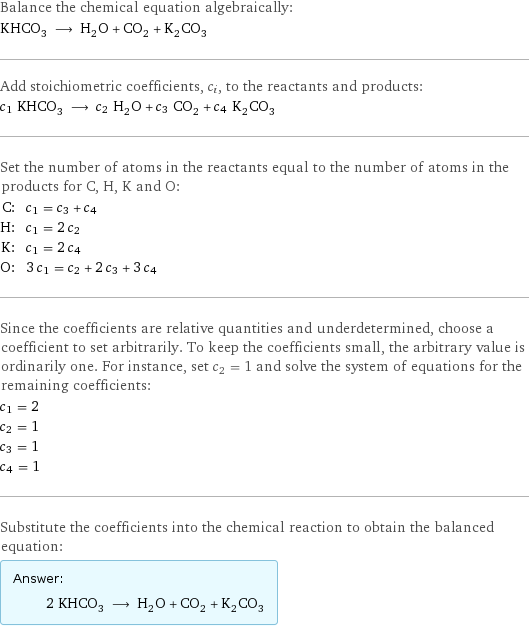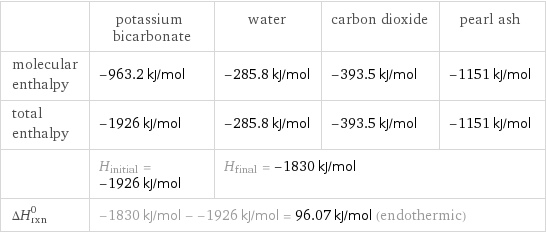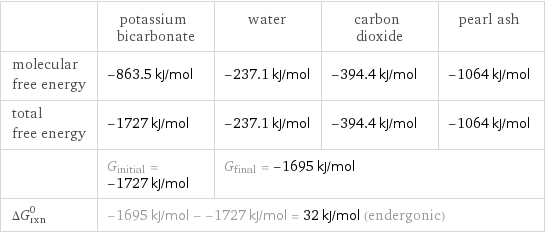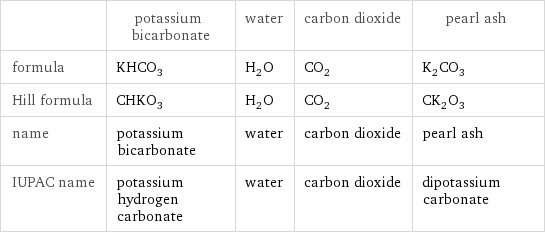Input interpretation

KHCO_3 potassium bicarbonate ⟶ H_2O water + CO_2 carbon dioxide + K_2CO_3 pearl ash
Balanced equation

Balance the chemical equation algebraically: KHCO_3 ⟶ H_2O + CO_2 + K_2CO_3 Add stoichiometric coefficients, c_i, to the reactants and products: c_1 KHCO_3 ⟶ c_2 H_2O + c_3 CO_2 + c_4 K_2CO_3 Set the number of atoms in the reactants equal to the number of atoms in the products for C, H, K and O: C: | c_1 = c_3 + c_4 H: | c_1 = 2 c_2 K: | c_1 = 2 c_4 O: | 3 c_1 = c_2 + 2 c_3 + 3 c_4 Since the coefficients are relative quantities and underdetermined, choose a coefficient to set arbitrarily. To keep the coefficients small, the arbitrary value is ordinarily one. For instance, set c_2 = 1 and solve the system of equations for the remaining coefficients: c_1 = 2 c_2 = 1 c_3 = 1 c_4 = 1 Substitute the coefficients into the chemical reaction to obtain the balanced equation: Answer: | | 2 KHCO_3 ⟶ H_2O + CO_2 + K_2CO_3
Structures

⟶ + +
Names

potassium bicarbonate ⟶ water + carbon dioxide + pearl ash
Reaction thermodynamics
Enthalpy

| potassium bicarbonate | water | carbon dioxide | pearl ash molecular enthalpy | -963.2 kJ/mol | -285.8 kJ/mol | -393.5 kJ/mol | -1151 kJ/mol total enthalpy | -1926 kJ/mol | -285.8 kJ/mol | -393.5 kJ/mol | -1151 kJ/mol | H_initial = -1926 kJ/mol | H_final = -1830 kJ/mol | | ΔH_rxn^0 | -1830 kJ/mol - -1926 kJ/mol = 96.07 kJ/mol (endothermic) | | |
Gibbs free energy

| potassium bicarbonate | water | carbon dioxide | pearl ash molecular free energy | -863.5 kJ/mol | -237.1 kJ/mol | -394.4 kJ/mol | -1064 kJ/mol total free energy | -1727 kJ/mol | -237.1 kJ/mol | -394.4 kJ/mol | -1064 kJ/mol | G_initial = -1727 kJ/mol | G_final = -1695 kJ/mol | | ΔG_rxn^0 | -1695 kJ/mol - -1727 kJ/mol = 32 kJ/mol (endergonic) | | |
Equilibrium constant
![Construct the equilibrium constant, K, expression for: KHCO_3 ⟶ H_2O + CO_2 + K_2CO_3 Plan: • Balance the chemical equation. • Determine the stoichiometric numbers. • Assemble the activity expression for each chemical species. • Use the activity expressions to build the equilibrium constant expression. Write the balanced chemical equation: 2 KHCO_3 ⟶ H_2O + CO_2 + K_2CO_3 Assign stoichiometric numbers, ν_i, using the stoichiometric coefficients, c_i, from the balanced chemical equation in the following manner: ν_i = -c_i for reactants and ν_i = c_i for products: chemical species | c_i | ν_i KHCO_3 | 2 | -2 H_2O | 1 | 1 CO_2 | 1 | 1 K_2CO_3 | 1 | 1 Assemble the activity expressions accounting for the state of matter and ν_i: chemical species | c_i | ν_i | activity expression KHCO_3 | 2 | -2 | ([KHCO3])^(-2) H_2O | 1 | 1 | [H2O] CO_2 | 1 | 1 | [CO2] K_2CO_3 | 1 | 1 | [K2CO3] The equilibrium constant symbol in the concentration basis is: K_c Mulitply the activity expressions to arrive at the K_c expression: Answer: | | K_c = ([KHCO3])^(-2) [H2O] [CO2] [K2CO3] = ([H2O] [CO2] [K2CO3])/([KHCO3])^2](../image_source/89ddb8e7896ed1c942bcf2d397bf1266.png)
Construct the equilibrium constant, K, expression for: KHCO_3 ⟶ H_2O + CO_2 + K_2CO_3 Plan: • Balance the chemical equation. • Determine the stoichiometric numbers. • Assemble the activity expression for each chemical species. • Use the activity expressions to build the equilibrium constant expression. Write the balanced chemical equation: 2 KHCO_3 ⟶ H_2O + CO_2 + K_2CO_3 Assign stoichiometric numbers, ν_i, using the stoichiometric coefficients, c_i, from the balanced chemical equation in the following manner: ν_i = -c_i for reactants and ν_i = c_i for products: chemical species | c_i | ν_i KHCO_3 | 2 | -2 H_2O | 1 | 1 CO_2 | 1 | 1 K_2CO_3 | 1 | 1 Assemble the activity expressions accounting for the state of matter and ν_i: chemical species | c_i | ν_i | activity expression KHCO_3 | 2 | -2 | ([KHCO3])^(-2) H_2O | 1 | 1 | [H2O] CO_2 | 1 | 1 | [CO2] K_2CO_3 | 1 | 1 | [K2CO3] The equilibrium constant symbol in the concentration basis is: K_c Mulitply the activity expressions to arrive at the K_c expression: Answer: | | K_c = ([KHCO3])^(-2) [H2O] [CO2] [K2CO3] = ([H2O] [CO2] [K2CO3])/([KHCO3])^2
Rate of reaction
![Construct the rate of reaction expression for: KHCO_3 ⟶ H_2O + CO_2 + K_2CO_3 Plan: • Balance the chemical equation. • Determine the stoichiometric numbers. • Assemble the rate term for each chemical species. • Write the rate of reaction expression. Write the balanced chemical equation: 2 KHCO_3 ⟶ H_2O + CO_2 + K_2CO_3 Assign stoichiometric numbers, ν_i, using the stoichiometric coefficients, c_i, from the balanced chemical equation in the following manner: ν_i = -c_i for reactants and ν_i = c_i for products: chemical species | c_i | ν_i KHCO_3 | 2 | -2 H_2O | 1 | 1 CO_2 | 1 | 1 K_2CO_3 | 1 | 1 The rate term for each chemical species, B_i, is 1/ν_i(Δ[B_i])/(Δt) where [B_i] is the amount concentration and t is time: chemical species | c_i | ν_i | rate term KHCO_3 | 2 | -2 | -1/2 (Δ[KHCO3])/(Δt) H_2O | 1 | 1 | (Δ[H2O])/(Δt) CO_2 | 1 | 1 | (Δ[CO2])/(Δt) K_2CO_3 | 1 | 1 | (Δ[K2CO3])/(Δt) (for infinitesimal rate of change, replace Δ with d) Set the rate terms equal to each other to arrive at the rate expression: Answer: | | rate = -1/2 (Δ[KHCO3])/(Δt) = (Δ[H2O])/(Δt) = (Δ[CO2])/(Δt) = (Δ[K2CO3])/(Δt) (assuming constant volume and no accumulation of intermediates or side products)](../image_source/c93824d8ef54eef7db24c1704a537b6d.png)
Construct the rate of reaction expression for: KHCO_3 ⟶ H_2O + CO_2 + K_2CO_3 Plan: • Balance the chemical equation. • Determine the stoichiometric numbers. • Assemble the rate term for each chemical species. • Write the rate of reaction expression. Write the balanced chemical equation: 2 KHCO_3 ⟶ H_2O + CO_2 + K_2CO_3 Assign stoichiometric numbers, ν_i, using the stoichiometric coefficients, c_i, from the balanced chemical equation in the following manner: ν_i = -c_i for reactants and ν_i = c_i for products: chemical species | c_i | ν_i KHCO_3 | 2 | -2 H_2O | 1 | 1 CO_2 | 1 | 1 K_2CO_3 | 1 | 1 The rate term for each chemical species, B_i, is 1/ν_i(Δ[B_i])/(Δt) where [B_i] is the amount concentration and t is time: chemical species | c_i | ν_i | rate term KHCO_3 | 2 | -2 | -1/2 (Δ[KHCO3])/(Δt) H_2O | 1 | 1 | (Δ[H2O])/(Δt) CO_2 | 1 | 1 | (Δ[CO2])/(Δt) K_2CO_3 | 1 | 1 | (Δ[K2CO3])/(Δt) (for infinitesimal rate of change, replace Δ with d) Set the rate terms equal to each other to arrive at the rate expression: Answer: | | rate = -1/2 (Δ[KHCO3])/(Δt) = (Δ[H2O])/(Δt) = (Δ[CO2])/(Δt) = (Δ[K2CO3])/(Δt) (assuming constant volume and no accumulation of intermediates or side products)
Chemical names and formulas

| potassium bicarbonate | water | carbon dioxide | pearl ash formula | KHCO_3 | H_2O | CO_2 | K_2CO_3 Hill formula | CHKO_3 | H_2O | CO_2 | CK_2O_3 name | potassium bicarbonate | water | carbon dioxide | pearl ash IUPAC name | potassium hydrogen carbonate | water | carbon dioxide | dipotassium carbonate
Substance properties

| potassium bicarbonate | water | carbon dioxide | pearl ash molar mass | 100.11 g/mol | 18.015 g/mol | 44.009 g/mol | 138.2 g/mol phase | solid (at STP) | liquid (at STP) | gas (at STP) | solid (at STP) melting point | 292 °C | 0 °C | -56.56 °C (at triple point) | 891 °C boiling point | | 99.9839 °C | -78.5 °C (at sublimation point) | density | 2.17 g/cm^3 | 1 g/cm^3 | 0.00184212 g/cm^3 (at 20 °C) | 2.43 g/cm^3 solubility in water | soluble | | | soluble surface tension | | 0.0728 N/m | | dynamic viscosity | | 8.9×10^-4 Pa s (at 25 °C) | 1.491×10^-5 Pa s (at 25 °C) | odor | odorless | odorless | odorless |
Units
